 Open Access
Open Access
ARTICLE
An Adaptive Firefly Algorithm for Dependent Task Scheduling in IoT-Fog Computing
Department of Computer Science, College of Science and Arts-Sharourah, Najran University, Najran Sharourah, 68378, Saudi Arabia
* Corresponding Author: Adil Yousif. Email:
(This article belongs to the Special Issue: Engineering Applications of Discrete Optimization and Scheduling Algorithms)
Computer Modeling in Engineering & Sciences 2025, 142(3), 2869-2892. https://doi.org/10.32604/cmes.2025.059786
Received 17 October 2024; Accepted 20 January 2025; Issue published 03 March 2025
Abstract
The Internet of Things (IoT) has emerged as an important future technology. IoT-Fog is a new computing paradigm that processes IoT data on servers close to the source of the data. In IoT-Fog computing, resource allocation and independent task scheduling aim to deliver short response time services demanded by the IoT devices and performed by fog servers. The heterogeneity of the IoT-Fog resources and the huge amount of data that needs to be processed by the IoT-Fog tasks make scheduling fog computing tasks a challenging problem. This study proposes an Adaptive Firefly Algorithm (AFA) for dependent task scheduling in IoT-Fog computing. The proposed AFA is a modified version of the standard Firefly Algorithm (FA), considering the execution times of the submitted tasks, the impact of synchronization requirements, and the communication time between dependent tasks. As IoT-Fog computing depends mainly on distributed fog node servers that receive tasks in a dynamic manner, tackling the communications and synchronization issues between dependent tasks is becoming a challenging problem. The proposed AFA aims to address the dynamic nature of IoT-Fog computing environments. The proposed AFA mechanism considers a dynamic light absorption coefficient to control the decrease in attractiveness over iterations. The proposed AFA mechanism performance was benchmarked against the standard Firefly Algorithm (FA), Puma Optimizer (PO), Genetic Algorithm (GA), and Ant Colony Optimization (ACO) through simulations under light, typical, and heavy workload scenarios. In heavy workloads, the proposed AFA mechanism obtained the shortest average execution time, 968.98 ms compared to 970.96, 1352.87, 1247.28, and 1773.62 of FA, PO, GA, and ACO, respectively. The simulation results demonstrate the proposed AFA’s ability to rapidly converge to optimal solutions, emphasizing its adaptability and efficiency in typical and heavy workloads.Keywords
The rapid evolution of the Internet of Things (IoT) has been a driving force behind numerous technological advancements, connecting an ever-growing array of devices and sensors [1–3]. An IoT system can be defined as a network of connected devices that interact and communicate with the cloud as well as between the devices themselves. IoT-Fog is a new computing paradigm that processes IoT data on servers close to the source of the data. Resource and task management in fog computing is considered a challenging problem due to the heterogeneity of IoT resources and the huge amount of data that need to be processed by fog servers [4,5]. Fog computing is an efficient computing solution that has been integrated into IoT systems as a complementary to cloud computing [6]. Fog computing aims to enhance the efficiency of IoT systems as the distributed fog servers process the IoT tasks near data sources, which reduces the processing and the communication latency [7–9]. The architecture of IoT-Fog computing systems consists of three main layers, as shown in Fig. 1.
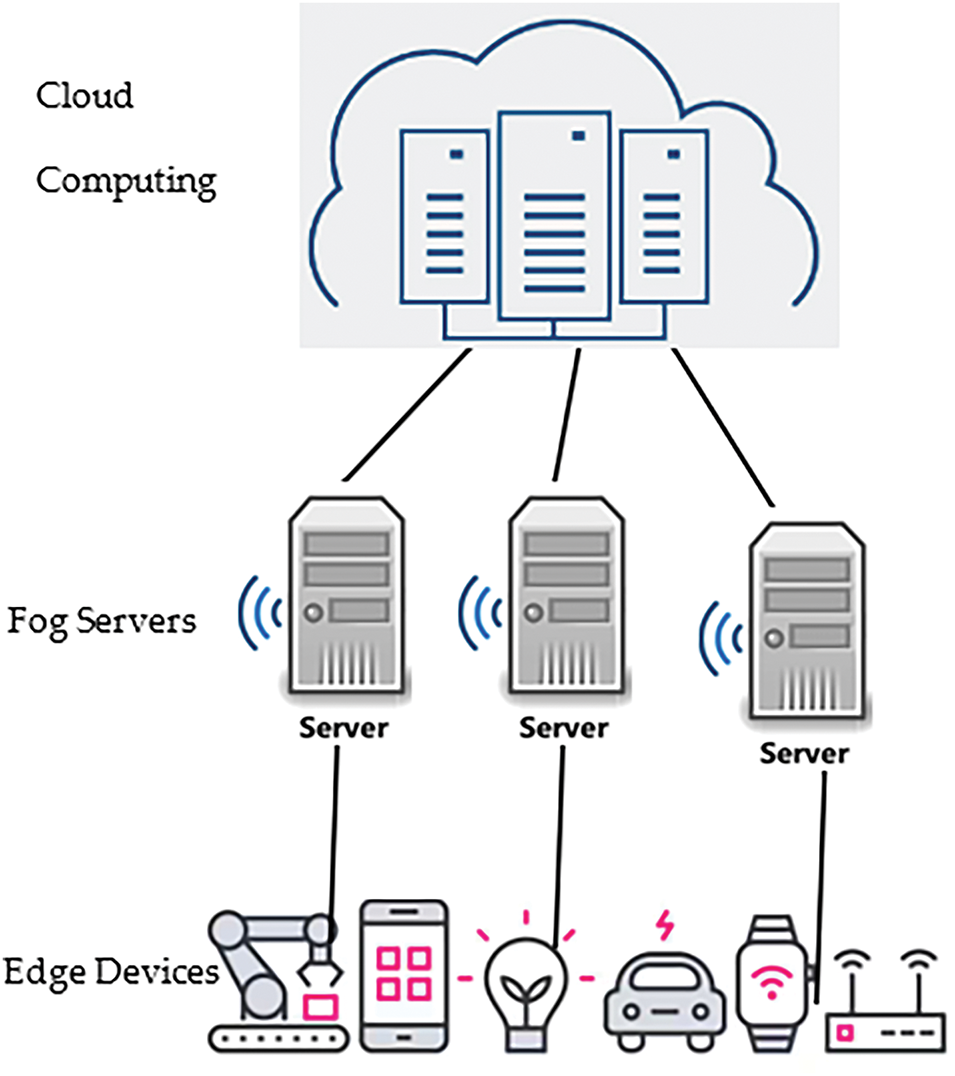
Figure 1: IoT-Fog computing solutions architecture
Fig. 1 describes the IoT-Fog computing architecture. The fog computing technology presents a multilayered approach to data processing within an Internet of Things (IoT) ecosystem. The first layer of the fog computing architecture is the thing layer. In this layer, various IoT devices such as sensors, actuaries, and mobile devices generate data or perform specific functions based on data they receive from the environment. The middle layer in the IoT solutions architecture is the fog computing layer. This layer consists of fog nodes, which are often distributed closer to the data source. Fog nodes perform preprocessing, analysis, and storage of data to reduce latency, decrease bandwidth usage, and enable quicker decision-making. The topmost layer is the cloud computing layer. The cloud layer contains centralized data centers with high computational and storage capabilities. In the IoT system, the application data that requires intensive computation or long-term storage is sent from the fog nodes to the cloud data centers [10].
Task scheduling in IoT-Fog computing involves distributing and allocating IoT tasks to fog nodes to optimize the fog system’s performance. Several task scheduling mechanisms are presented in the literature to schedule IoT-Fog computing tasks [11–13]. Integrating fog computing into IoT networks introduces new complexities, particularly in resource management, such as resource allocation and task scheduling [14,15]. The IoT-Fog tasks are critical in optimizing the performance of fog computing environments, requiring a balance between response time, cost, and resource utilization [12,16].
However, due to the heterogeneity of IoT-Fog resources and the dependencies between tasks, the scheduling process in fog computing is considered a challenging problem. The current task scheduling mechanism in IoT-Fog computing provides good but not optimal solutions [15,17]. Optimization mechanisms are used for task scheduling in IoT-Fog computing. The Firefly Algorithm mimics the behavior of fireflies and is a form of swarm intelligence, and it is adept at solving complex optimization problems [18–20].
The rapid growth of the Internet of Things (IoT) has introduced new challenges in managing fog computing resources effectively. IoT systems produce massive amounts of data that require efficient processing to maintain low latency and high reliability. IoT-Fog computing aims to allocate IoT tasks to devices closer to the data source. The main goals of IoT-Fog computing are to minimize system latency and increase its reliability. In IoT-Fog systems, the heterogeneity of resources and the dynamic nature of tasks produce significant challenges for the IoT-Fog computing task scheduling process. Dependent task scheduling in IoT-Fog computing environments requires an optimal mechanism considering synchronization requirements and communication delays [21–23].
Current task scheduling mechanisms present a good but not optimal scheduling process in IoT-Fog computing environments with synchronization requirements and communication delays. The main problem of scheduling dependent tasks in IoT-Fog computing is finding an optimal mapping between fog tasks and the available resources to optimize the allocation process that considers synchronization requirements and communication delays [24,25].
The main objective of this study is to present an Adaptive Firefly Algorithm (AFA) for dependent task scheduling in IoT-Fog computing. The fitness function of the proposed AFA mechanism considers three important factors: the execution times of tasks, the impact of task synchronization and the communication time between IoT-Fog computing tasks. As IoT-Fog computing depends mainly on distributed fog node servers that dynamically receive tasks, tackling the communications and synchronization issues between dependent tasks is becoming a challenging problem. The proposed AFA aims to address the dynamic nature of IoT-Fog computing environments. The proposed AFA mechanism considers a dynamic light absorption coefficient to control the decrease in attractiveness over iterations. Furthermore, the light absorption coefficient function provides an adaptive control of the exploration–exploitation balance over time in the proposed AFA mechanism. Considering the multilayered architecture of IoT-Fog computing, the proposed AFA mechanism is situated primarily in the Fog layer, where it adaptively schedules the IoT tasks to the fog nodes.
This study presents an Adaptive Firefly Algorithm (AFA) for dependent task scheduling in IoT-Fog computing environments. The proposed AFA uniquely incorporates a dynamic light absorption coefficient that adapts based on workload and iteration progress, enhancing convergence speed and solution accuracy. Furthermore, the proposed AFA mechanism addresses critical task synchronization and communication times issues, which are essential in dynamic fog computing scenarios with interdependent tasks. The simulation results revealed the proposed AFA’s superiority under different workloads compared to established algorithms. The proposed AFA provides a significant improvement in scheduling efficiency, making it a valuable contribution to the IoT-Fog computing literature.
Additionally, the adaptive light absorption coefficient in our AFA dynamically balances exploration and exploitation, enhancing convergence speed and solution quality over iterations. This adaptive mechanism is not present in the evolutionary algorithm approach discussed in the cited work.
The method presented in [26] presents an evolutionary algorithm (EA) for clustering and scheduling tasks in IoT edge computing. This method is primarily focusing on improving resource utilization and reducing latency through task clustering. In contrast, the proposed AFA mechanism introduces an Adaptive Firefly Algorithm (AFA) tailored specifically for dependent task scheduling in IoT-Fog computing environments. The proposed AFA addresses task execution times and handle task synchronization and communication delays between dependent tasks, which are important issues in dynamic IoT-Fog networks.
The motivation for this research stems from the need to efficiently manage fog computing nodes, handling task dependencies, and considering the synchronization delays and communication overhead in the scheduling process.
This paper has five sections. Section 2 analyzes the related works. Section 3 demonstrates the proposed Adaptive Firefly Algorithm for task scheduling. Section 4 illustrates the performance evaluation. The conclusion is presented in Section 5.
The Internet of Things (IoT) has emerged as an essential future technology. However, IoT devices suffer from limitations in computation and storage capacity [27]. Cloud computing is integrated with IoT to process IoT device’s data remotely on the internet [28,29]. Regardless of efforts to improve IoT applications with cloud capabilities, IoT device computation issues remain unresolved, as IoT applications generally demand specific features such as mobility, geographical distribution, location awareness, and low latency [30,31]. Fog computing technology was introduced as a solution to enable computing at the edge of the network, offering new services for IoT devices [8,32,33]. In IoT-Fog computing, fog servers are the computing nodes that provide computational resources for IoT applications at the network edge [34]. In IoT-Fog computing, resource management processes such as resource allocation and task scheduling aim to provide short execution times and cost-effective computation processes for IoT devices [35–37]. In this context, enhancing the IoT task scheduling in IoT-Fog computing is crucial for optimizing the performance of IoT environments. The literature reveals a range of mechanisms and methods addressing task scheduling in IoT-Fog computing, focusing on improving the execution times of applications [17,38–40].
The study in [41] presents a bees swarm mechanism for enhancing scheduling in fog computing. The bees swarm mechanism is the trade-off between power consumption and computation latency when scheduling tasks in fog computing. The study in [42] proposed a job scheduling mechanism for IoT-Fog computing based on a modified artificial ecosystem-based optimization to choose a fog computing provider and allocate the IoT jobs on it [42]. Furthermore, the study in [33] has improved the Harris Hawks Optimization (HHO) mechanism and introduced a Discrete Opposition-based mechanism, indicated as DO-HHO, for IoT-Fog computing task scheduling.
A classification study of IoT-Fog computing task scheduling mechanisms on the basis of multiple factors such as throughput, execution times, and fairness of resource allocation is introduced in [43]. The classification process revealed that traditional task scheduling mechanisms have shown certain limitations in handling the dynamic nature of IoT-Fog computing environments [43].
Several studies in the literature examined have focused on adaptable and robust IoT task scheduling mechanisms, such as those offered by swarm intelligence [13,44,45].
Task scheduling mechanisms based on Particle Swarm Optimization (PSO) and Ant Colony Optimization (ACO) have been observed for their efficiency in resource management and task scheduling in IoT-Fog computing [46,47]. Furthermore, there is a growing interest in exploring alternative swarm-based mechanisms that could offer even greater efficiency and adaptability in IoT-Fog computing task scheduling [48,49]. Puma Optimizer (PO) is a new metaheuristic mechanism that mimics the intelligence and life of Pumas. PO has considered efficient exploration and exploitation techniques to enhance the optimization process [50]. The study in [51] presented a modified firefly algorithm for addressing task scheduling in cloud-edge environments. A new study in [52] presented task allocation mechanism using the fitness function of two metaheuristic methods: The Krill Herd Algorithm (KHA) and PSO. An artificial Hummingbird mechanism for task scheduling in fog computing is combined with Opposition-Based Learning (OBL) optimization to optimize the scheduling process [53].
This study explores the application of an Adaptive Firefly Algorithm for task scheduling in fog computing for IoT networks. The standard Firefly Algorithm, characterized by its simplicity and flexibility, mimics fireflies’ social and communicative behaviors [54–56]. By adopting the Firefly Algorithm for task scheduling in IoT-Fog computing, this research aims to contribute to the growing body of knowledge in efficient resource management for optimizing the IoT-Fog computing performance [57].
3 The Proposed Adaptive Firefly Algorithm for Task Scheduling in Fog Computing
This study proposes an Adaptive Firefly Algorithm (AFA) for optimizing the independent task scheduling process in IoT-Fog computing. The proposed AFA is a modified version of the standard Firefly Algorithm (FA) considering the execution times of the submitted tasks, the impact of synchronization requirements and the communication time between dependent tasks. As IoT-Fog computing depends mainly on distributed fog node servers that receive tasks in a dynamic manner, tackling the communications and synchronization issues between dependent tasks is becoming a challenging problem. The proposed AFA aims to address the dynamic nature of IoT-Fog computing environments.
3.1 The Proposed Algorithm Architecture
The structure of the proposed AFA mechanism for task scheduling in IoT-Fog computing consists of five phases: initialization, fitness evaluation, attractiveness and movement, iterative optimization, and convergence. The first phase of the proposed AFA mechanism is the initialization phase, in which the proposed AFA mechanism generates an initial random population of fireflies. Each firefly in the initial population represents a schedule of fog computing tasks to resources. The second phase of the proposed AFA mechanism is the fitness evaluation phase, in which each schedule in the firefly’s population is evaluated using the objective function of the proposed AFA. The fitness function of the proposed AFA mechanism considers three important factors: the execution times of tasks, the impact of task synchronization and the communication time between IoT-Fog computing tasks. As in the standard Firefly Algorithm, the firefly’s fitness represents the firefly’s attractiveness or brightness, and the population movements are based on the attractiveness and the distance between the fireflies. In the proposed AFA mechanism, the attractiveness corresponds to the efficiency of the schedule. The attractiveness of a firefly decreases with the distance, which here represents the dissimilarity between population schedules. In the proposed AFA mechanism, each schedule in the population moves towards brighter fireflies, meaning schedules with less fitness value are more likely to be emulated. In the iterative optimization phase, in each iteration, every schedule in the firefly population adjusts its position in response to other fireflies to find a more efficient scheduling position in the solution search space. In the movement equation of the proposed AFA mechanism, the randomness factor α ensures that the proposed AFA mechanism explores different areas of the solution search space. This process enhances the search space convergence and prevents the mechanism from trapping in local optimal solutions. The last phase of the proposed AFA mechanism is the convergence phase. In this phase, the proposed AFA mechanism iteratively enhances the population schedules of each generation, converging towards an optimal or near-optimal solution. The optimal schedule is the one that achieves the best fitness value based on the objective function for all submitted tasks across the fog nodes. The key features of the proposed AFA mechanism are adaptability and efficiency. The proposed AFA mechanism adapts its movement parameters based on the synchronization process and the communication times between dependent IoT-Fog tasks. Furthermore, the proposed AFA mechanism is adaptable to various task scheduling scenarios in IoT-Fog computing and capable of handling dynamic and heterogeneous IoT-Fog environments. By minimizing task execution times, the proposed AFA mechanism enhances the overall efficiency of the IoT-Fog computing system. The proposed AFA mechanism is suitable for IoT networks utilizing fog computing, where efficient resource utilization and quick response times are crucial. By optimizing task scheduling, the proposed AFA mechanism can significantly improve the performance of the IoT-Fog computing system, leading to more efficient and reliable IoT-Fog applications.
The communication type in the proposed AFA mechanism follows a broker-based approach. In the proposed AFA mechanism, a central broker or scheduler is configured [6]. This central broker is responsible for managing task assignments, coordinating communication between dependent tasks, and synchronizing task execution between the various fog computing nodes [58].
3.2 Mathematical Modelling of the Proposed AFA Mechanism
The following subsections provide an overview of how the proposed AFA mechanism works by describing its objective functions, population movements and convergence process. The process of the proposed AFA mechanism iterates continuously to adjust the population schedules, searching for more optimal solutions.
3.2.1 The Proposed AFA Mechanism Initialization
Let T=[t1,t2,…tn] represent a set of n IoT-Fog computing-dependent tasks that are to be scheduled on R=[r1,r2,..…rm] a set of m IoT-Fog server resources with corresponding speeds S={s1,s2,…,sm}.
Let C={cij∣1≤i,j≤n} represent the communication time required between tasks ti and task tj. This is particularly relevant for dependent tasks where data need to be transferred from one task to another.
Let S={sij∣1≤i,j≤n} represent the synchronization times between tasks ti and task tj, capturing the additional time needed to synchronize ta6sks that are dependent on each other.
Let L={l1,l2,…,ln} represent the lengths of n IoT-Fog computing tasks, where li is the length of the task ti.
Initialize the first random firefly population Y0=[y1,y2,…yk], where k is the number of fireflies. In the firefly population, yi is a scheduling vector representing a task-fog server mapping, as each element in yi corresponds to an IoT-Fog server resource allocated to a fog task.
The initialization phase of the proposed AFA mechanism is considered an important step as it sets the basis for the following exploration and exploitation phases of the AFA mechanism. This phase starts by generating a random initial population of fireflies. Each firefly in the population corresponds to a candidate solution for the task scheduling problem in the IoT-Fog environment. In the proposed AFA mechanism, the position of each firefly in the initial population is generated randomly within the solution search space, ensuring a diverse scheduling candidate at the beginning of the optimization process. This randomness process in the proposed AFA mechanism is constrained by the feasible schedules in the solution search space, considering the task synchronization and the communication time. The randomness process in the proposed AFA mechanism is based on a permutation function P(r). P(r) allocates the IoT-Fog tasks to fog server resources randomly. For each yi, P(r) generates a random sequence of resource indices for the IoT-Fog task allocation. The initial position of each firefly yi is determined by applying P(r) for the set of IoT-Fog tasks resulting in a random but feasible IoT-Fog task–resource mapping. The initial allocation for firefly yi can be expressed as in Eq. (1):
yi=P(r)(T)(1)
where P(r)(T) denotes the application of the random permutation function to the set of IoT-Fog tasks T, resulting in a random task–resource mapping that satisfies the IoT-Fog scheduling’s constraints.
3.2.2 The AFA Mechanism Objective Function (Fitness Evaluation)
The proposed AFA mechanism calculates the execution time of each schedule in the population using the objective function. The execution time function considers the fog task length, fog resource speed, and the overheads due to communication and synchronization between dependent tasks.
The execution time eij for task ti on resource rj can be calculated by dividing the task length by the resource speed and adding any communication and synchronization overheads. If task ti is dependent on the task tk, the communication time cik and synchronization time sik need to be included in the execution time calculations. The proposed AFA mechanism calculates the execution time as in Eq. (2):
eij=lisj+∑k∈D(i)(cik+sik)(2)
where D(i) represents the set of tasks that ti is directly dependent on, and it is assumed that cik and sik are zero if there is no direct dependency between tasks ti and tk. The proposed AFA calculates the total execution time of a schedule TEyi as the sum of all individual IoT-Fog task execution times, adjusted for any additional wait times due to dependencies and synchronization requirements.
Eq. (2) calculates the execution time (eij) for task i when assigned to resource j. The execution time is consisting three components lisj,cik and sik. lisj term represents the processing time, where li is the length of the task and sj is the speed of the resource. The communication delay between task iand other dependent tasks, accounting for data transfer times between fog servers. sik is the synchronization delay, which represents the waiting time required to synchronize with dependent tasks. In real IoT-Fog environments, tasks often depend on each other, requiring both communication and synchronization delays to be considered in the total execution time.
If IoT-Fog computing tasks are executed in parallel, the total execution time is influenced by the task with the longest execution path, including dependencies, as in Eq. (3):
TEyi=max∀ti∈T(∑k∈D(i)eik)(3)
where D(i) includes task ti and all its dependencies. This formula calculates the maximum sum of execution times along any dependency path in the schedule. For example, assume a simple case with three tasks (t1,t2,t3) where t2 depends on t1, and t3 depends on t2, and each task is assigned to a different resource. If the execution times including dependencies are 10, 20, and 15 ms, respectively, the total execution time would be the time taken to complete t3, which is the last task in this dependency chain.
The objective function of the proposed AFA mechanism can be defined as in Eq. (4):
minimizeF(Y)=∑ni=1∑mj=1xij(lisj+∑k∈D(i)(cik+sik))(4)
where
• xij is a binary variable that equals 1 if task ti is assigned to resource rj and 0 otherwise.
• li is the length of task ti.
• sj is the speed of resource rj.
• cik is the communication time required between task ti and task tk.
• sik is the synchronization time required between task ti and task tk
• D(i) represents the set of tasks that task ti is directly dependent on.
The dependency constraints model the dependencies between fog computing tasks to ensure that a task can only start if its dependent tasks have finished. The dependency constraint model defines the start time tstarti to represent the starting time of task ti and the finish time tfinishi to represent the finishing time of task ti calculated as the start time of task ti plus its execution time as in Eq. (5):
tfinishi=tstarti+eij(5)
where eij is the execution time of IoT-Fog task ti on resource rj.
To ensure that task ti does not start until all tasks tk that it depends on have completed, the proposed AFA mechanism impose the following constraints for all tasks ti and their dependencies tk in set D(i), which contains the indices of tasks that have be completed before task ti can start as described in Eq. (6):
tstarti≥tfinishk∀k∈D(i)(6)
This constraint ensures that the start time of task ti is greater than or equal to the finish time of each task tk it depends on.
Consider an example of fog computing scenario with three tasks t1, t2, and t3, where t2 depends on t1 (i.e., t2 cannot start until t1 is completed). t3 depends on both t1 and t2. The mathematical Constraints can be defined as:
tstart2≥tfinish1
tstart3≥tfinish2
tstart3≥tfinish1(if t3also depends directly on t1)
If t1, t2, and t3 have execution times based on the resource they are assigned to, the equations also consider these values. For instance, if t1 is assigned to r1, t2 to r2, and t3 to r3, and each task–resource pair has a known execution time eij, then:
tfinish1=tstart1+e11
tfinish2=tstart1+e22
tfinish3=tstart1+e33
These dependency constraints of modeling are crucial for scheduling dependent tasks in IoT-Fog computing environments, where tasks are interdependent. The scheduling process needs to consider not only resource allocation but also the order and timing of task execution.
3.2.3 Movement and Update of Fireflies of the Proposed AFA Mechanism
The third step of the proposed AFA mechanism is the movement of fireflies in the population towards a more attractive one. The proposed AFA mechanism updates the position of the firefly i towards the more attractive firefly j using Eq. (7) [14]:
yi+1=yi+β0e−γd2ij(yi−yj)+α⋅(rand−0.5)(7)
where β0 is attractiveness at a distance of 0 (the execution time calculated using Eq. (3)), γ is the light absorption coefficient, dij is the distance between the schedules yi and yj, α is the randomization parameter, and rand is a random number in [0, 1]. The distance between fireflies in the proposed AFA mechanism represents the dissimilarity between population schedules. The proposed AFA mechanism orders the fog resources in ascending order based on their speeds and calculates the distance between schedules as the difference in their resource allocations. This method transforms the distance between schedules into a sequence comparison task, where the sequence elements are the ordered positions of resources based on their speeds.
Considering the set of resources R, the proposed AFA mechanism orders the resources in ascending order of their speeds to obtain an ordered set Rordered={ro1,ro2,…,rom}, where so1≤so2≤…≤som. As defined previously, each schedule yi in the firefly population represents a sequence of resource allocations to tasks, where each element in the sequence corresponds to the ordinal position of the allocated resource in the ordered set Rordered. For example, if the task t1 in schedule yi is allocated to the fastest resource (which is now ro1), the first element of yi would be 1, representing the first position in the ordered resource list. Given two schedules yi and yj, each represented as a sequence of ordinal positions yi=[oi1,oi2,…,oin] and yj=[oj1,oj2,…,ojn] (with n tasks), the distance between these schedules based on the difference in resource allocations is calculated as in Eq. (8):
d(yi,yj)=∑nk=1∣oik−ojk∣(8)
where ∣oik−ojk∣ calculates the absolute difference in the ordinal positions of the resources allocated to the task tk in schedules yi and yj. This metric captures the dissimilarity in terms of resource allocation speed preferences between the two schedules. This distance calculation quantifies the differences between two IoT-Fog computing task schedules in terms of their resource speed. For example, consider a fog computing system with four resources R={r1,r2,r3,r4} with corresponding speeds S={2,5,1,10}. After ordering by speed, Rordered={r3,r1,r2,r4}. Suppose schedule yi assigns tasks to resources based on some criteria, resulting in the allocation sequence corresponding to their speeds: yi=[r3,r1,r2,r4] and schedule yj has a different allocation as yj=[r1,r4,r3,r2], the distance d(yi,yj) can be calculated as:
d(yi,yj)=∣1−2∣+∣2−4∣+∣3−1∣+∣4−3∣
d(yi,yj)=1+2+2+1=6
The calculated distance of 6 represents the cumulative difference in resource allocation positions between schedules yi and yj. This example shows that in the two different schedules yi and yj some tasks are allocated to resources with more similar speed differences of 1, while other tasks are allocated to resources with more disparate speed differences (differences of 2).
3.2.4 Optimization Process of the Proposed AFA Mechanism
In the proposed AFA mechanism, the optimization phase iterates the scheduling process for a predefined number of generations or until convergence. As defined in the movement phase, the proposed AFA mechanism updates the positions of IoT-Fog schedules based on their relative attractiveness and calculates the new fitness. Based on the objective function, the optimal IoT-Fog computing schedule is the one with the minimum total execution time considering the synchronization and the communication time between dependent tasks. The proposed AFA mechanism considers a dynamic light absorption coefficient γ to control the decrease in attractiveness over iterations. The proposed AFA mechanism defines the light absorption coefficient γ as a function of iteration number iter. The light absorption coefficient function γ(iter) provide an adaptive control of the exploration–exploitation balance over time in the proposed AFA mechanism. The function of γ(iter) is described in Eq. (9):
γ(iter)=γ0⋅e−λ⋅iter(9)
where γ0 is the initial light absorption coefficient at iter=0, λ is a decay rate that determines how fast the exploration–exploitation balance changes towards exploitation and iter is the current iteration number. In the proposed AFA mechanism, the optimization process starts with a higher γ(iter) making the population schedules move towards distant schedules, resulting in high exploration for the solution search space. This process allows the proposed AFA mechanism to explore more areas of the solution space, searching for potential schedules. As the optimization iterations progress, the light absorption coefficient γ(iter) decreases, and the AFA mechanism changes to optimization exploitation. In the exploitation phase, the population schedules are less influenced by far-away schedules. This process makes the proposed AFA mechanism focus more on refining the population schedules found so far instead of searching for new schedules.
3.2.5 Convergence Criterion of the Proposed AFA Mechanism
The last phase of the proposed AFA mechanism is the optimization convergence criterion. In this phase, the proposed AFA mechanism defines two approaches to applying the convergence criterion: a threshold in the change in fitness values and a maximum number of iterations.
The termination criteria for the proposed AFA mechanism optimization process have two forms: a predefined maximum number of iterations and when an optimal or near-optimal solution is found. The proposed AFA mechanism considers a predefined maximum number of iterations of the optimization process as iter≥Tmax, where iter the current iteration number of optimizations and Tmax is the maximum allowed number of iterations. The second termination condition of the proposed AFA mechanism is when the change in the best fitness value over a certain number of optimization iterations is below a predefined threshold, as stated in Eq. (10):
Terminate if ∣fbest(iter)−fbest(iter−Δiter)∣<ϵ(10)
fbest(iter) is the best fitness value at iteration iter,Δiter is a specified number of previous iterations to compare against and ϵ is the convergence threshold parameter.
The assumptions of the proposed Adaptive Firefly Algorithm (AFA) are based on practical scenarios in IoT-Fog computing. The proposed mechanism assumes tasks arrive dynamically as in real-world IoT systems where data is generated and processed in real-time. Furthermore, the proposed AFA mechanism considered task dependencies, such as synchronization and communication delays, which are common in distributed fog networks where tasks often rely on each other’s output.
3.3 The Proposed Algorithm Pseudo-Code
The provided pseudo-code outlines the Adaptive Firefly Algorithm for Dependent Task Scheduling in IoT-Fog computing. This detailed pseudo-code illustrates each step of the proposed AFA mechanism. The key elements of the proposed AFA mechanism, such as the initialization of parameters and the repetitive process of optimization, play a crucial role in attaining the targeted results in independent task scheduling in IoT-Fog computing (see Algorithm 1):
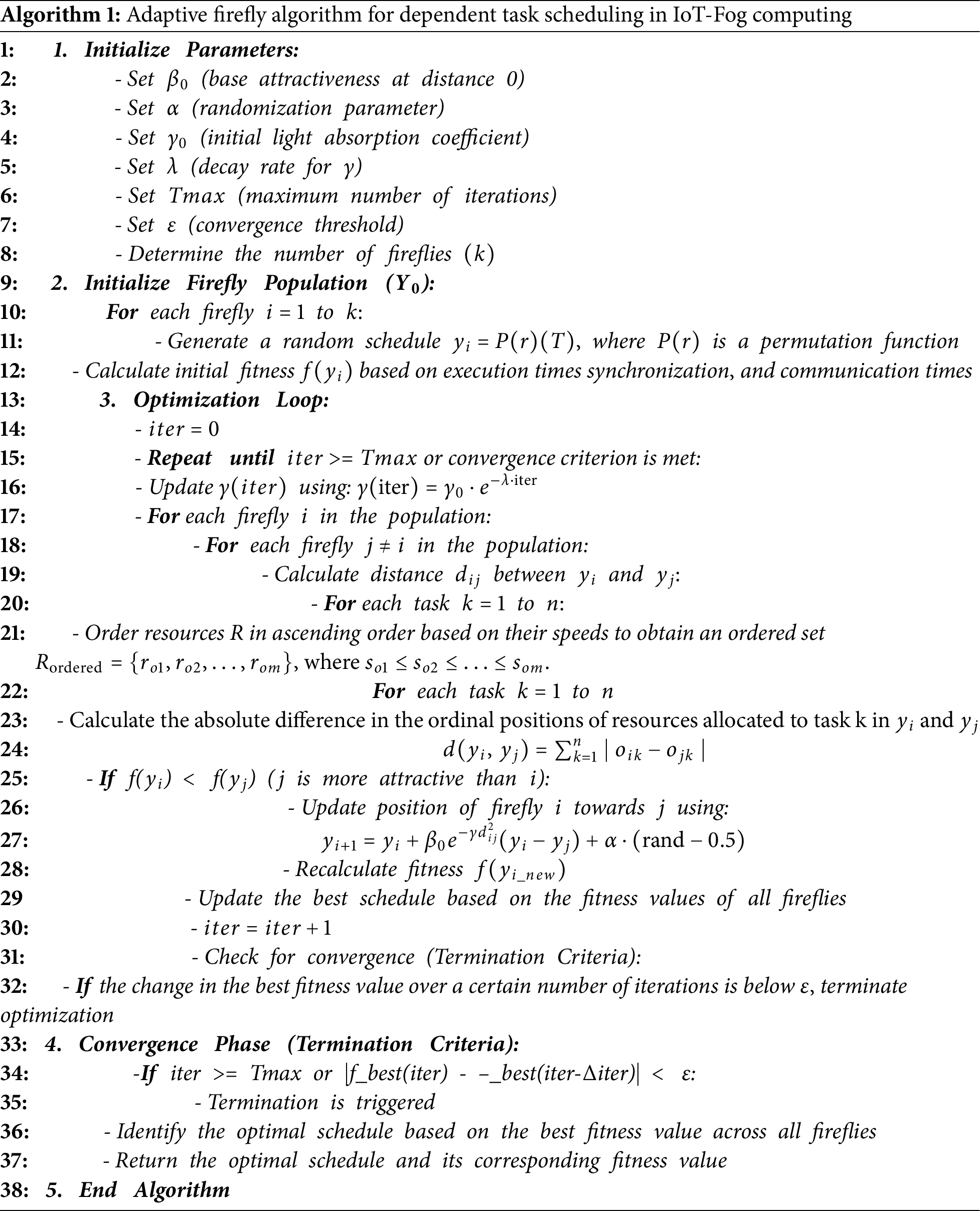
This study conducted several simulation experiments to evaluate the performance of the proposed Adaptive Firefly Algorithm (AFA) in IoT-Fog computing. In the simulation process, this study considered three distinct scenarios with varying numbers of jobs and resources to test the performance of the proposed Adaptive Firefly Algorithm (AFA) in different situations.
The parameters for the proposed Adaptive Firefly Algorithm (AFA) were selected based on optimization methods in the literature and fine-tuned through experiments. The main parameters of the proposed mechanism such as population size, light absorption coefficient (γ), and attractiveness (β) were set to balance exploration and exploitation. To ensure experiments fairness, the proposed AFA mechanism was compared against FA, PO, GA, and ACO under different workload scenarios. Each mechanism executed for 100 iterations and the average execution time is calculated.
Server Specifications: The simulations were performed on a DELL server equipped with an Intel(R) Core(TM) i9-10900 CPU, operating at 2.80 GHz with 9 cores and 32 GB of RAM.
Operating System: Ubuntu 20.04 LTS.
Simulation Software: The experiments were conducted using Java version 21, leveraging libraries such as Apache Commons Math for numerical computations to ensure precise execution of the algorithms. To fairly evaluate the proposed Adaptive Firefly Algorithm (AFA) mechanism, the simulation experimentation selected a mix of both well-established and modern optimization algorithms for comparison. These include the standard Firefly Algorithm (FA), Genetic Algorithm (GA), Ant Colony Optimization (ACO), and the recently developed Puma Optimizer (PO). The simulation considered PO specifically because it represents a strong, up-to-date optimization method, making it a valuable benchmark. All the mechanisms were tested under the same simulation conditions, using identical hardware, software environments, and a range of workload scenarios (light, typical, and heavy).
Firefly Algorithm (FA) and Adaptive Firefly Algorithm (AFA)
• Population size: 50 fireflies
• Light absorption coefficient (γ): 1.0
• Attractiveness (β0): 0.2
• Dynamic adjustment factor for AFA: Details provided in Section 3.2.4 on how γ is adjusted over iterations.
Puma Optimization
• Population size: 50
• Stalking factor r = 0.1
• Ambush factor = 1.0
• Hunt factor = 1.0
• Mutation rate = 0.1
Genetic Algorithm (GA)
• Population size: 50 chromosomes
• Crossover rate: 0.8
• Mutation rate: 0.02
Ant Colony Optimization (ACO)
• Number of ants: 50
• Pheromone evaporation rate (ρ): 0.5
Workload Characteristics
• Task Characteristics: Tasks varied from 1 KB to 10 MB, representing diverse IoT applications.
• Resource Characteristics: Fog nodes varied in computational capabilities from low-power edge devices to high-performance servers.
Scenarios
• Lightweight Load: 10 tasks distributed among 3 fog nodes.
• Typical Load: 50 tasks distributed among 10 fog nodes.
• Heavy Load: 100 tasks distributed among 20 fog nodes.
Iteration Process
• Each algorithm was run for 100 iterations, with execution times recorded for task allocation, computation, and communication overhead.
• Random Seed: A constant seed (e.g., seed = 42) was used in all simulations to ensure repeatability.
This section describes the simulation experiments and the results.
4.2.1 The First Scenario: Lightweight Load
Fig. 2 presents the execution times for the proposed Adaptive Firefly Algorithm (AFA) across 100 iterations under a lightweight load. The results in this scenario reveal a consistent improvement in the execution times of the proposed AFA mechanism. In the first few iterations, the results show that the execution times are stable at approximately 186.37 ms. A significant drop to 155.85 ms is obtained in iteration 9. A gradual improvement in the AFA execution times is achieved in a number of iterations from 10 to 38. Another reduction in the execution times to 122.65 ms is achieved in iteration number 42. Towards the end of the 100 iterations of the simulation process, the proposed AFA mechanism execution times decrease further to 122.65 ms and then to 116.89 ms, with the final iterations stabilizing at approximately 113.19 ms.
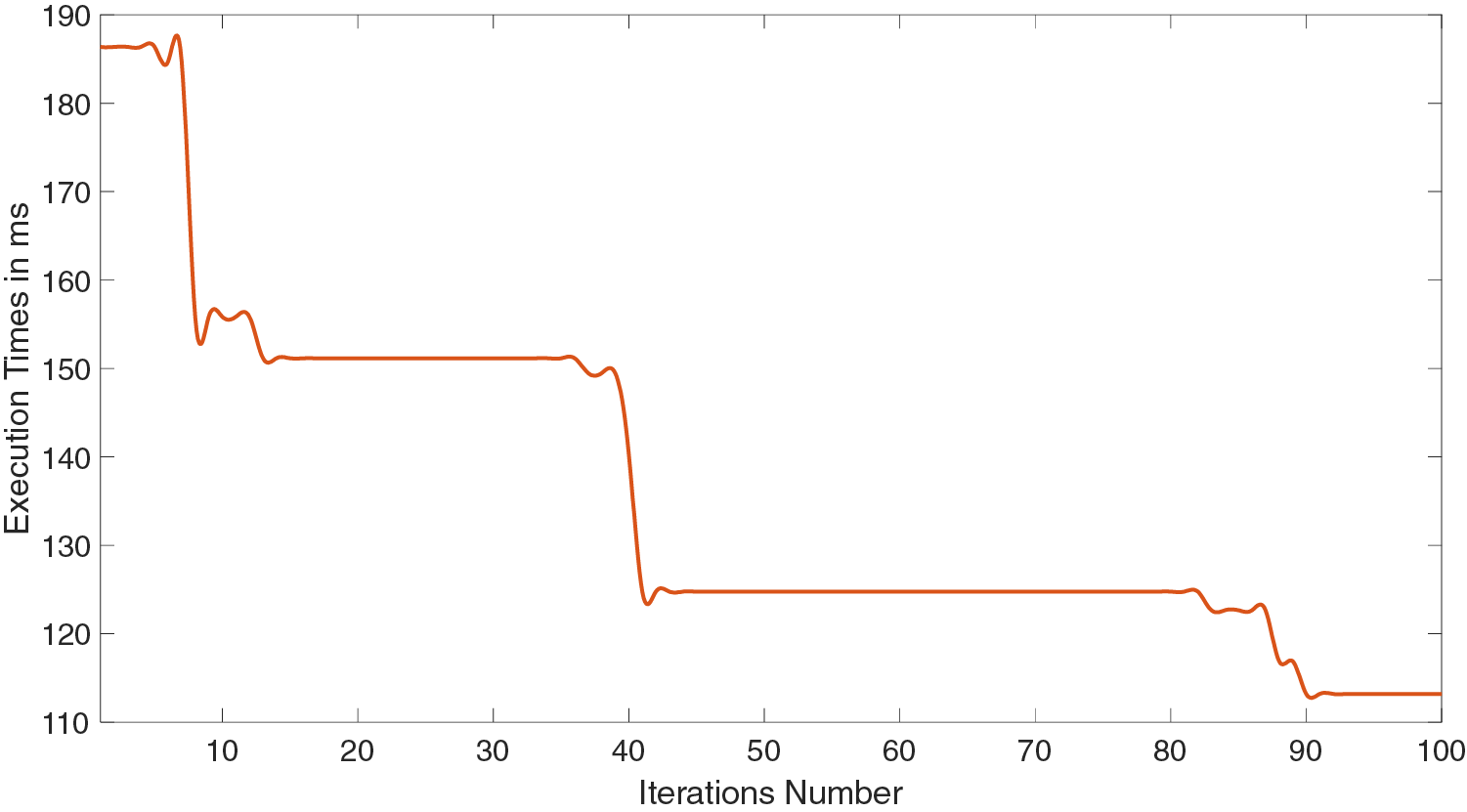
Figure 2: The execution times of 100 iterations of the proposed AFA (Lightweight load)
Table 1 and Fig. 3 compare the execution times of the proposed Adaptive Firefly Algorithm (AFA) algorithm with the standard Firefly Algorithm (FA), Puma Optimizer (PO), Genetic Algorithm (GA), and Ant Colony Optimization (ACO) across different iterations under a lightweight load. The proposed AFA mechanism for task scheduling in IoT-Fog computing started with 251.31 ms execution time at the first iteration of the optimization process. The execution times of the proposed AFA mechanism continue to improve significantly as iterations progress. In the 50th iteration, the final execution time was reduced significantly to 134.54 ms. The execution times of the remaining scheduling mechanisms in the last iteration were FA, 209.59, PO, 109.44, GA, 247.95, and ACO, 395.93 ms. The ACO mechanism for task scheduling in IoT-Fog computing has the worst execution at 412.01 ms. These results show that the PO mechanism has the shortest execution times in optimizing execution times under lightweight load scenarios.

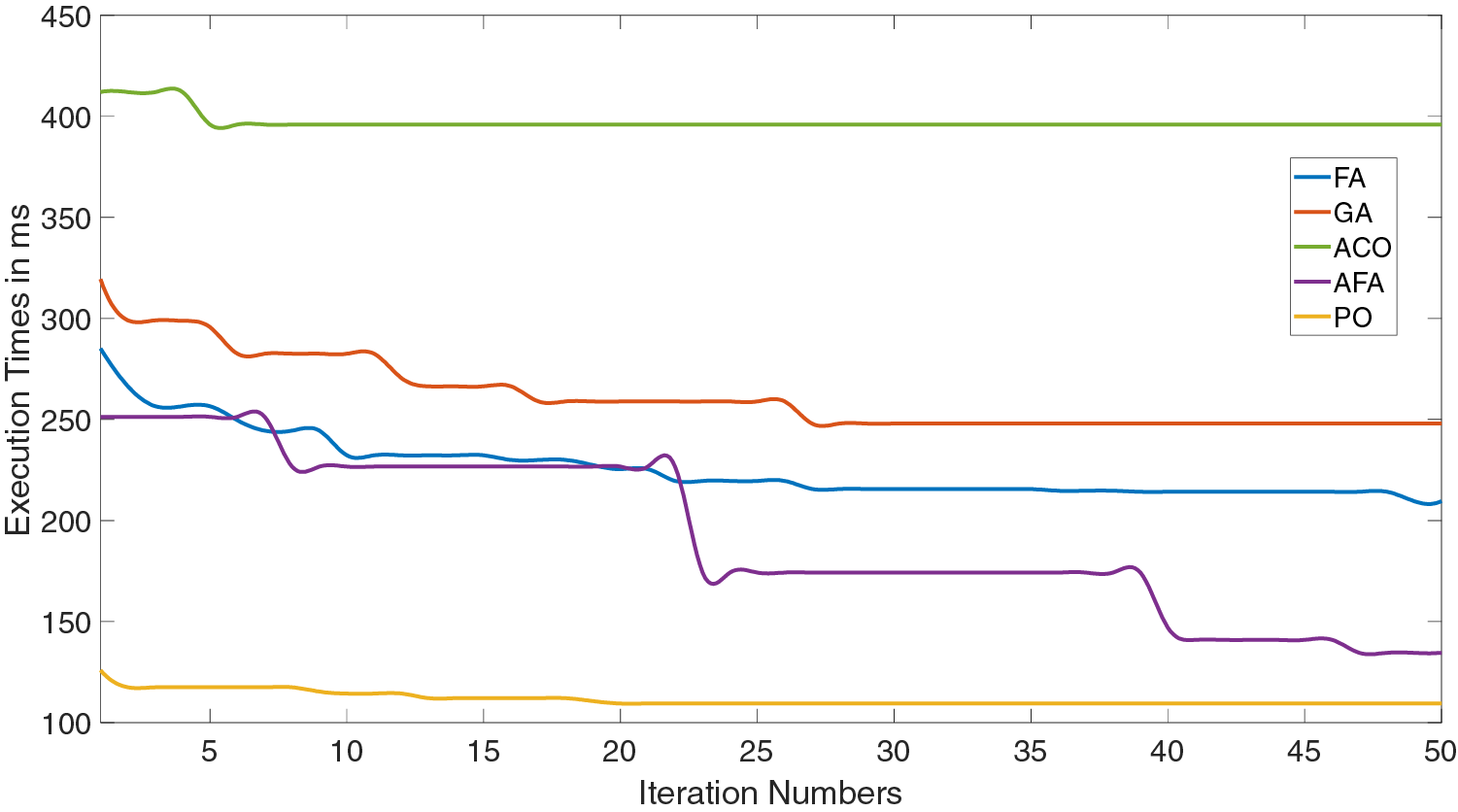
Figure 3: The execution times of the proposed AFA compared to FA, PO, GA and ACO (Lightweight load)
Table 2 and Fig. 4 compare the average execution times of the proposed AFA, FA, PO, GA, and ACO mechanisms when dealing with a lightweight workload scenario. The proposed PO mechanism demonstrates the best performance with an average execution time of 111.65 ms, while the average execution times of the proposed AFA, FA, GA, and ACO mechanisms were 193.03, 226.20, 261.66, and 397.22 ms, respectively.

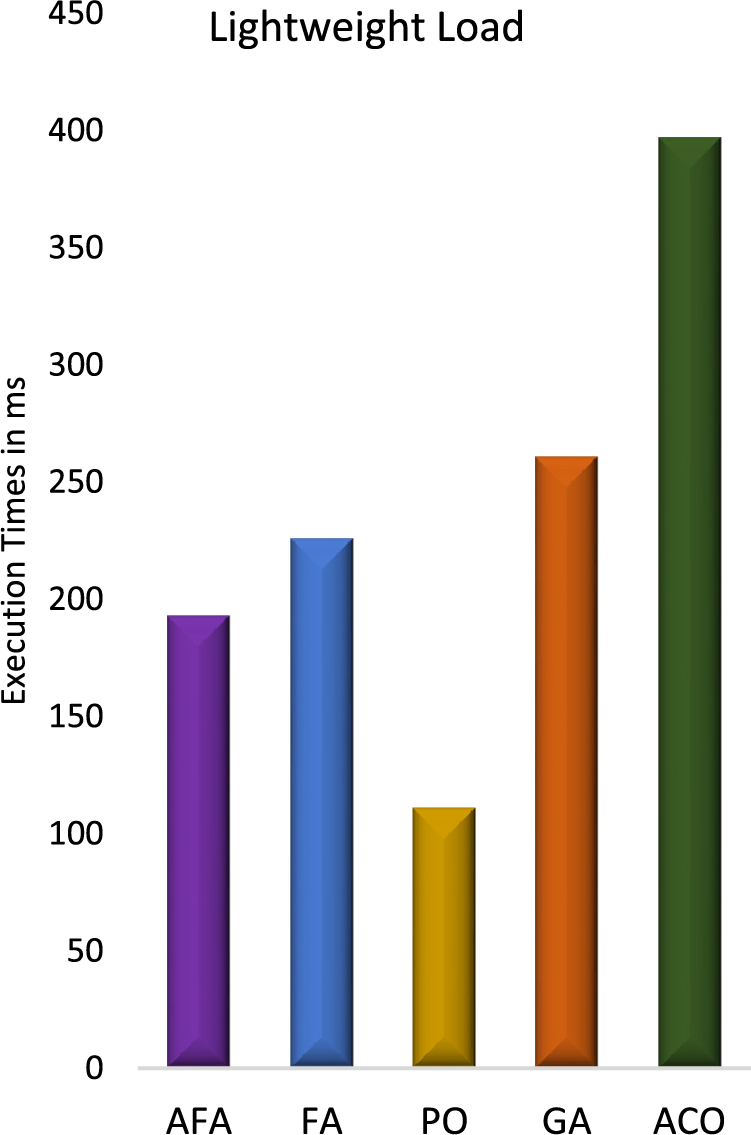
Figure 4: The average execution times of the proposed AFA compared to GA and ACO (Lightweight load)
4.2.2 The Second Scenario: Typical Load
As shown in Fig. 5, under a typical load scenario, the proposed Adaptive Firefly Algorithm (AFA) consistently improves its execution times. In the first iteration, the execution time of the proposed Adaptive Firefly Algorithm (AFA) was 509.79 ms. In the next iterations, the execution times of the proposed AFA mechanism dropped to 443.50 ms. Then, the proposed AFA mechanism optimization process showed a consistent decrease in the execution times until it reached 430.61 ms in the final iteration.
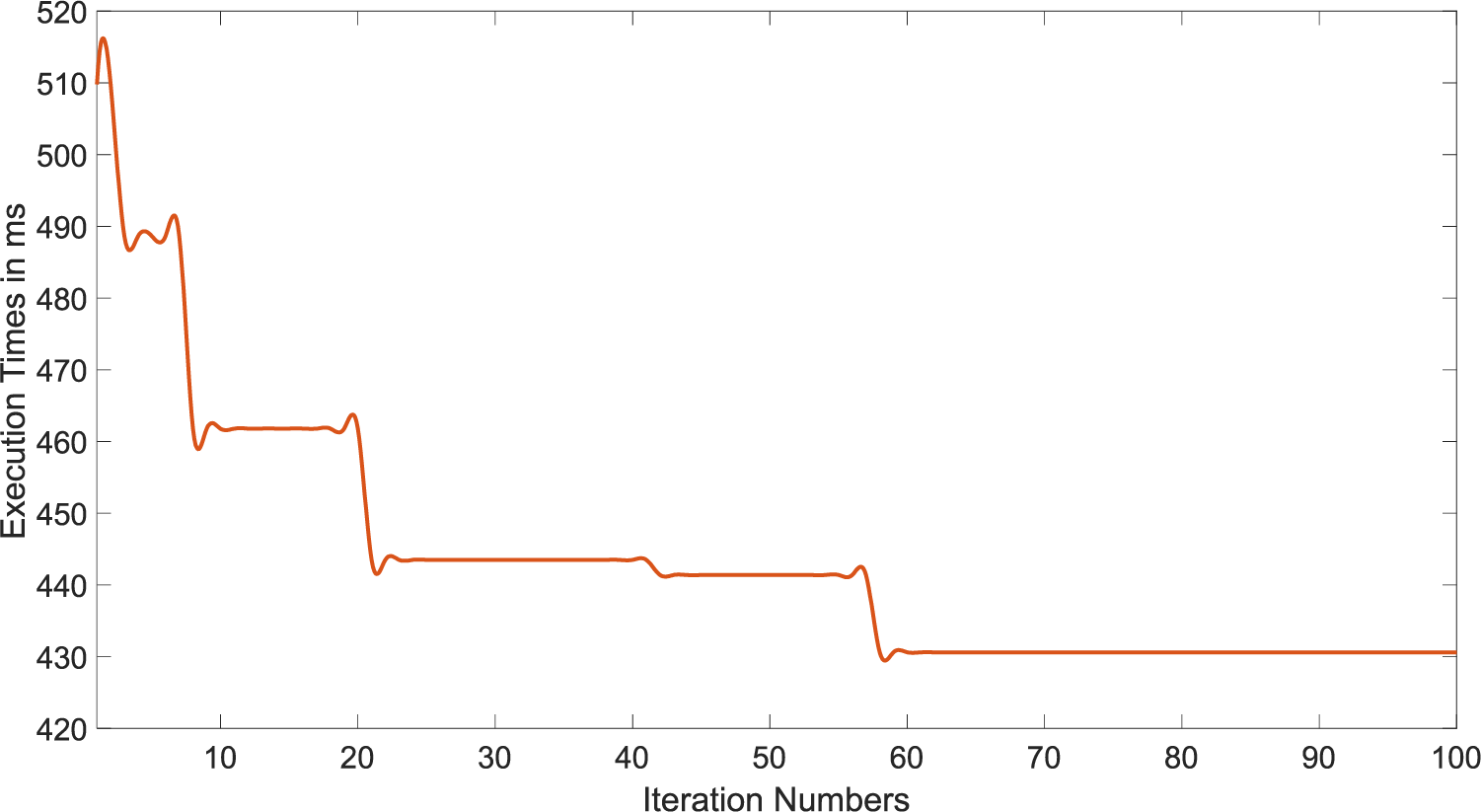
Figure 5: The execution times of 100 iterations of the proposed AFA (Typical load)
In summary, the proposed AFA mechanism for IoT-Fog scheduling in a typical workload scenario revealed a gradual decrease and stabilization of execution times.
Under a typical load scenario, the proposed AFA mechanism revealed efficient execution times compared to the FA, PO, GA, and ACO mechanisms described in Table 3 and Fig. 6. Throughout the simulation iterations, the four mechanisms improved execution times; however, the proposed AFA mechanism consistently performed the best in optimizing the execution times. In the last iteration of the simulation process, the execution time of the proposed mechanism was 419.73 ms compared to 428.49, 524.63, 565.39, and 877.62 ms for FA, PO, GA and ACO, respectively. These results emphasize the proposed AFA’s potential as a highly effective task-scheduling mechanism for IoT-Fog computing in typical workloads.


Figure 6: The execution times of the proposed AFA compared to FA, PO, GA and ACO (Typical load)
As shown in Table 4 and Fig. 7, the average execution time for the proposed Adaptive Firefly Algorithm AFA was 437.78 ms, while the average execution times of FA, PO, GA, and ACO were 467.34, 602.41, 575.98, and 878.32, respectively. These results indicate that the proposed algorithm has the shortest execution times on average compared to FA, GA, and ACO in a typical load scenario.

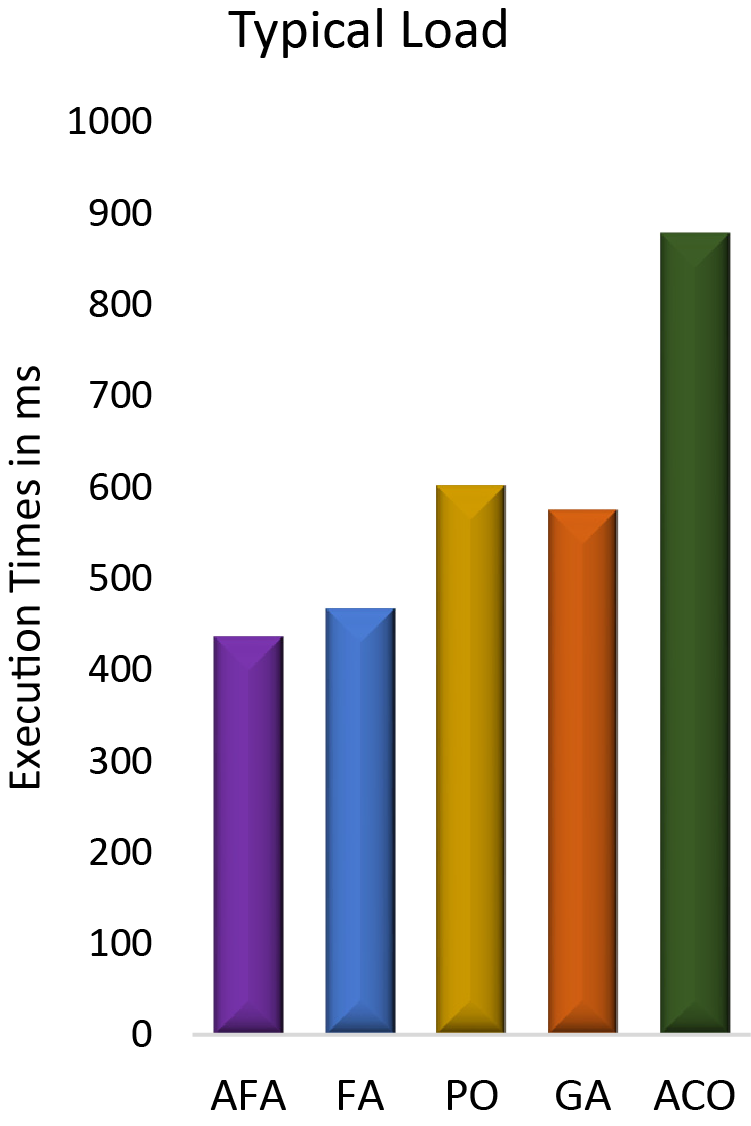
Figure 7: The average execution times of the proposed AFA compared to FA, PO, GA and ACO (Typical load)
4.2.3 The Third Scenario: Heavy Load
In the case of heavy load conditions, the proposed AFA mechanism started with a higher execution time of 1081.42 ms, as visualized in Fig. 8. Then, the execution time dropped to 1015.65 ms, indicating early optimization improvement. The next iteration of the optimization process revealed a gradual reduction in execution times until it stabilized at 935.86 ms for a long number of iterations. Towards the end of the 100 iterations, the proposed AFA mechanism showed a slow reduction in the execution time, ending with 882.90 ms at the last iteration.
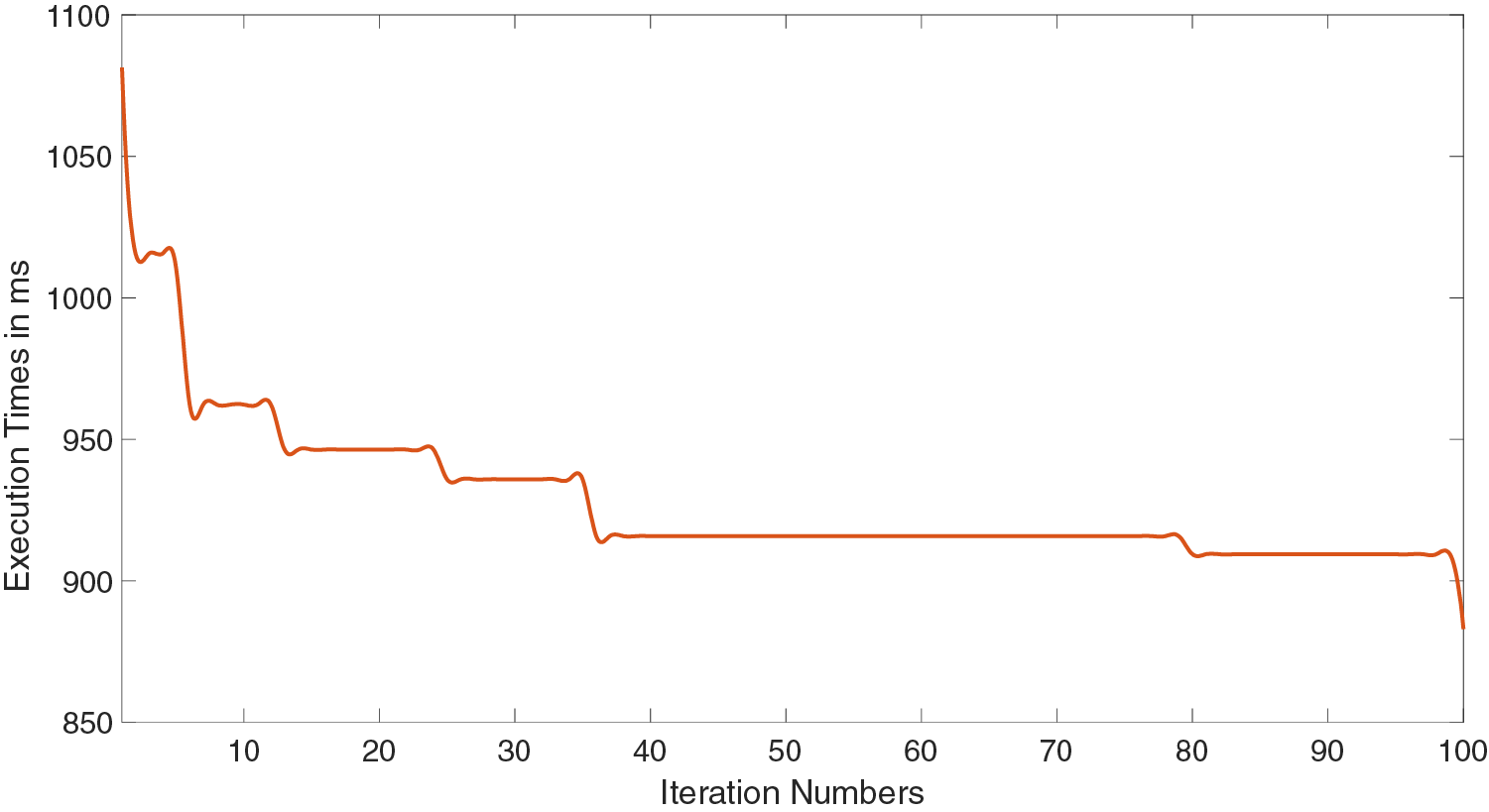
Figure 8: The execution times of 100 iterations of the proposed AFA (Heavy load)
Table 5 and Fig. 9 present the execution times for the proposed AFA mechanism compared to the standard FA, PO, GA, and ACO mechanisms under a heavy load condition. The proposed AFA mechanism begins with an execution time of 1104.90 ms, which is less than the execution times of FA (1227.09 ms), PO (1712.11 ms), GA (1369.14 ms), and ACO (1901.72 ms). The standard FA started at 1227.09 ms, indicating better optimization integration than GA and ACO. As iterations advance, the proposed AFA mechanism for IoT-Fog scheduling significantly improves. The execution times decreased to 864.93 ms by the 40th iteration and remained constant until the end of the simulation. The standard FA’s results also show a good performance in the execution times through the optimization iterations by reducing the execution time to 865.36 ms, close to AFA’s by the 50th iteration of the simulation. However, GA and ACO obtained longer execution times, ending with 1193.04 and 1763.48 ms, respectively.

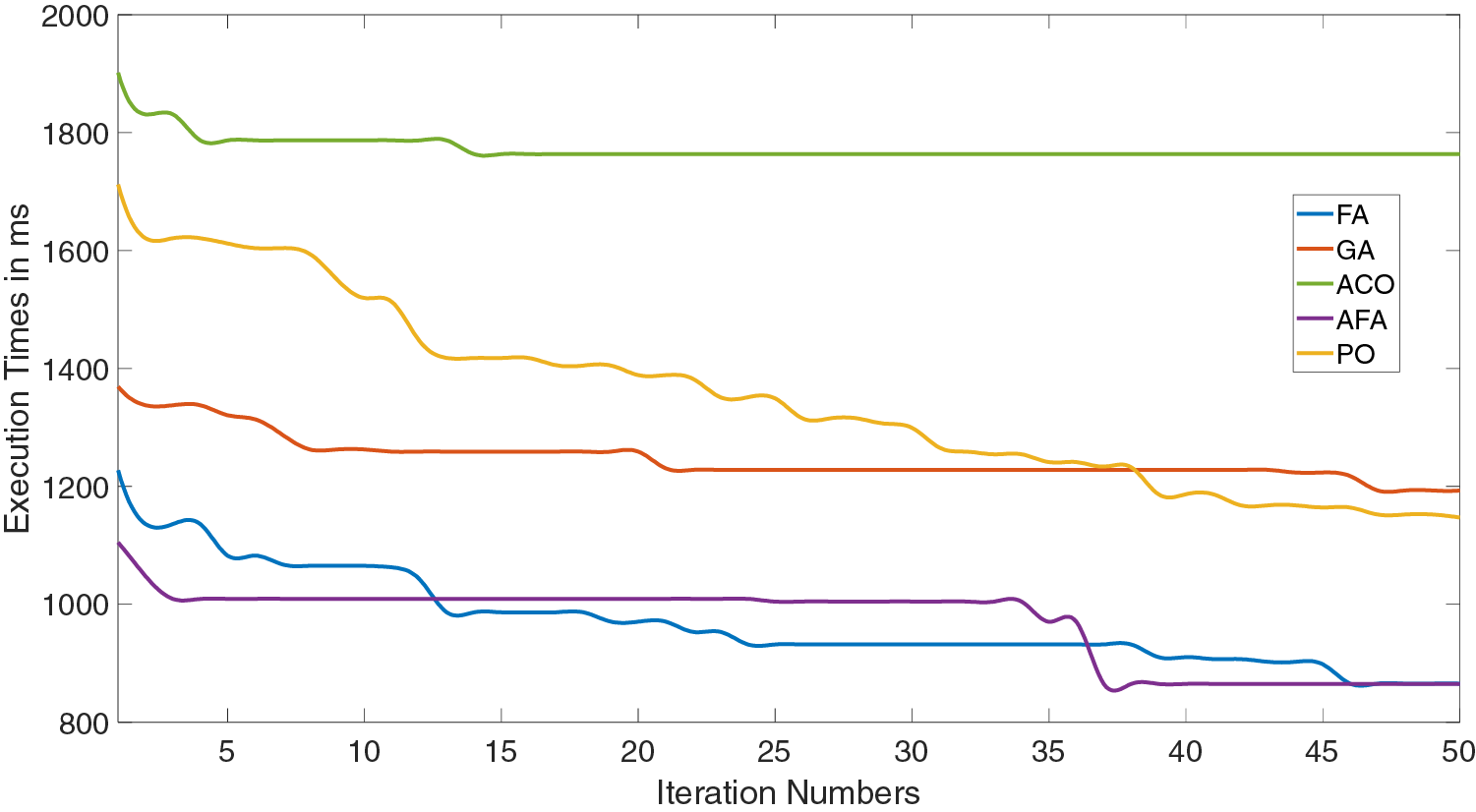
Figure 9: The execution times of the proposed AFA compared to FA, PO, GA and ACO (Heavy load)
In summary, Table 5 and Fig. 9 demonstrate that the proposed AFA mechanism for task scheduling in IoT-Fog computing outperformed FA, GA and ACO mechanisms under heavy load conditions.
Table 6 and Fig. 10 provide the average execution times for the proposed AFA mechanism compared to standard FA, PO, GA, and ACO mechanisms in heavy workload scenarios. The proposed AFA mechanism obtained the shortest average execution time, 968.98 ms. The average execution times of FA, PO, GA, and ACO in heavy workloads were 970.96, 1352.87, 1247.28, and 1773.62, respectively.

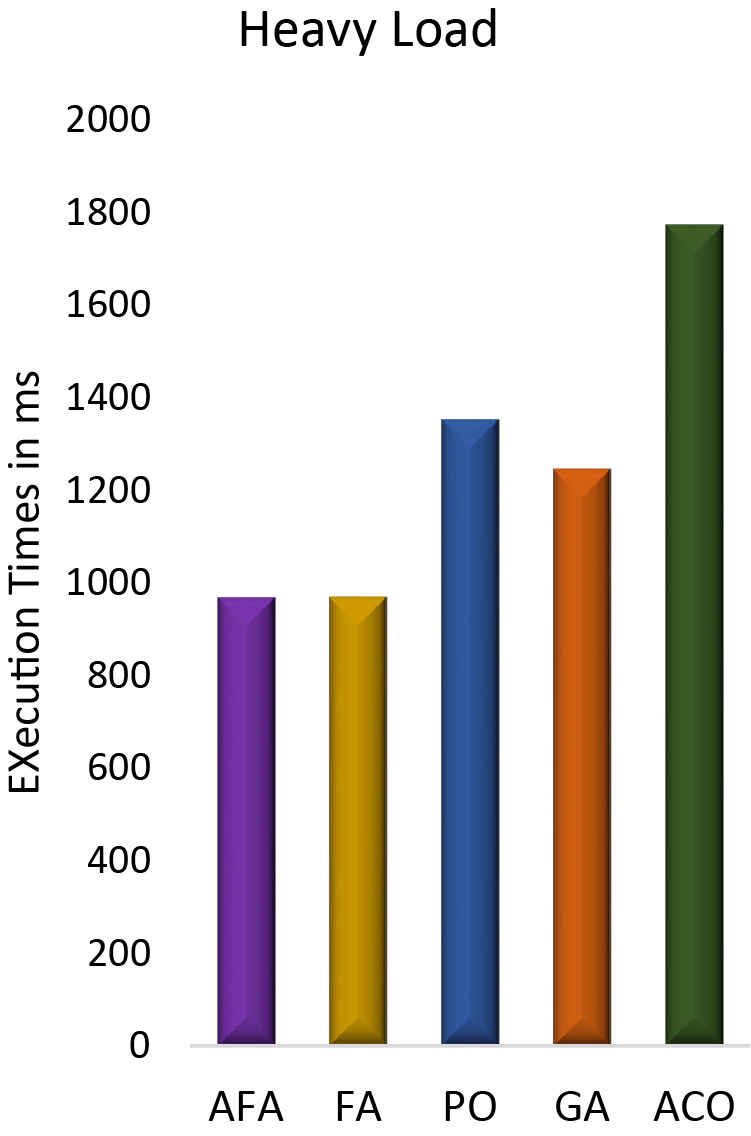
Figure 10: The average execution times of the proposed AFA compared to FA, PO, GA and ACO (Heavy load)
The simulation experiments demonstrate that the proposed Adaptive Firefly Algorithm (AFA) mechanism effectively reduces execution time and handles task dependencies under various workloads (light, typical, and heavy). These results indicate that the proposed AFA mechanism can scale to large-sized fog computing networks with dynamic task arrivals. However, as the number of tasks and fog nodes increases significantly, the proposed AFA mechanism computational overhead may rise due to the iterative nature of the firefly algorithm for the task scheduling optimization process. In terms of robustness, the proposed AFA mechanism adaptively balances the optimization exploration and exploitation process, which allows the proposed mechanism to perform well under different workloads.
This section presents the main results of the proposed adaptive firefly algorithm for dependent task scheduling in IoT-Fog computing.
4.3.1 The Results of the Study
The proposed Adaptive Firefly Algorithm (AFA) performance was evaluated under three workload scenarios—light, typical, and heavy—using execution time as an evaluation metric. The proposed AFA considered the synchronization requirements and communication delays in the execution times calculations.
The simulation results demonstrate consistent improvement in execution times across all scenarios, with AFA achieving an average execution time of 968.98 ms under heavy workloads compared to 970.96, 1352.87, 1247.28, and 1773.62 ms for FA, PO, GA, and ACO, respectively.
The experimentation process considered a statistical analysis to confirm that the proposed AFA mechanism achieves faster convergence and more efficient scheduling solutions than other scheduling mechanisms. Under typical workloads, the proposed AFA mechanism reduced execution time by approximately 7% compared to FA and 24% compared to GA. These improvements in execution times are due to the dynamic light absorption coefficient, which balances exploration and exploitation during optimization.
4.3.3 Comparison with Related Work
Current task scheduling mechanisms, such as the Artificial Hummingbird Algorithm, focus on optimizing resource allocation processes and latency reduction of the submitted tasks. However, these mechanisms lack the techniques to adapt dynamically to synchronization and communication delays. The proposed AFA mechanism design addresses these challenges, making it more robust in handling dependent tasks in dynamic IoT-Fog environments.
The proposed AFA mechanism’s robustness and scalability suit large-scale IoT-Fog computing environments with varied workloads. AFA adaptability allows IoT-Fog computing system to perform well in stable and dynamic environments, providing a practical solution for IoT applications requiring low latency and efficient resource utilization.
This study proposed an Adaptive Firefly Algorithm (AFA) for dependent task scheduling in IoT-Fog computing. The performance evaluation of the proposed Adaptive Firefly Algorithm (AFA) under typical and heavy workloads confirms its efficiency in IoT-Fog computing job scheduling. The proposed AFA mechanism consistently outperforms the standard Firefly Algorithm (FA), Puma Optimizer (PO), Genetic Algorithm (GA) and Ant Colony Optimization (ACO) across typical and heavy load scenarios. Puma Optimizer (PO) obtained the shortest execution time under a lightweight load. The proposed AFA’s ability to identify and exploit efficient task schedules proves its potential for real-time applications in IoT-Fog networks. The proposed AFA mechanism balanced the scheduling solution search space exploration and exploitation process. This balance significantly enhanced adaptability to task scheduling optimization’s proposed AFA mechanism.
However, the proposed AFA mechanism has some limitations. Its computational overhead may be significant for resource-constrained environments such as wireless sensor networks (WSNs). Furthermore, the proposed AFA mechanism’s energy consumption is another consideration, as its iterative nature may not be optimal for battery-powered devices.
Future work will address these limitations by optimizing the proposed AFA mechanism for low-power environments. Furthermore, future work may explore the AFA’s scalability and robustness in larger-scale fog computing networks and potential combinations with other optimization mechanisms for enhanced performance of IoT-Fog computing.
Acknowledgement: We are thankful to the Deanship of Graduate Studies and Scientific Research at Najran University for funding this work under the Easy Funding Program grant code (NU/EFP/SERC/13/166).
Funding Statement: The authors are thankful to the Deanship of Graduate Studies and Scientific Research at Najran University for funding this work under the Easy Funding Program grant code (NU/EFP/SERC/13/166).
Availability of Data and Materials: The authors confirm that the data supporting the findings of this study are available within the article.
Ethics Approval: Not applicable.
Conflicts of Interest: The author declares no conflicts of interest to report regarding the present study.
References
1. Madakam S, Ramaswamy R, Tripathi S. Internet of Things (IoTa literature review. J Comput Commun. 2015;3(5):164–73. doi:10.4236/jcc.2015.35021. [Google Scholar] [CrossRef]
2. Gokhale P, Bhat O, Bhat S. Introduction to IoT. Int Adv Res J Sci Eng Technol. 2018;5(1):41–4. [Google Scholar]
3. Mohamad Noor MB, Hassan WH. Current research on Internet of Things (IoT) security: a survey. Comput Netw. 2019;148:283–94. doi:10.1016/j.comnet.2018.11.025. [Google Scholar] [CrossRef]
4. Ni J, Zhang K, Lin X, Shen X. Securing fog computing for Internet of Things applications: challenges and solutions. IEEE Commun Surv Tutor. 2018;20(1):601–28. doi:10.1109/COMST.2017.2762345. [Google Scholar] [CrossRef]
5. Bittencourt L, Immich R, Sakellariou R, Fonseca N, Madeira E, Curado M, et al. The Internet of Things, fog and cloud continuum: integration and challenges. Internet Things. 2018;3:134–55. doi:10.1016/j.iot.2018.09.005. [Google Scholar] [CrossRef]
6. Morabito R, Cozzolino V, Ding AY, Beijar N, Ott J. Consolidate IoT edge computing with lightweight virtualization. IEEE Netw. 2018;32(1):102–11. doi:10.1109/MNET.2018.1700175. [Google Scholar] [CrossRef]
7. Atlam H, Walters R, Wills G. Fog computing and the Internet of Things: a review. Big Data Cogn Comput. 2018;2(2):10. doi:10.3390/bdcc2020010. [Google Scholar] [CrossRef]
8. Anawar MR, Wang S, Azam Zia M, Jadoon AK, Akram U, Raza S. Fog computing: an overview of big IoT data analytics. Wirel Commun Mob Comput. 2018;2018(1):7157192. doi:10.1155/2018/7157192. [Google Scholar] [CrossRef]
9. Dastjerdi AV, Buyya R. Fog computing: helping the Internet of Things realize its potential. Computer. 2016;49(8):112–6. doi:10.1109/MC.2016.245. [Google Scholar] [CrossRef]
10. Khezri E, Yahya RO, Hassanzadeh H, Mohaidat M, Ahmadi S, Trik M. DLJSF: data-locality aware job scheduling IoT tasks in fog-cloud computing environments. Results Eng. 2024;21:101780. doi:10.1016/j.rineng.2024.101780. [Google Scholar] [CrossRef]
11. Mukherjee M, Guo M, Lloret J, Iqbal R, Zhang Q. Deadline-aware fair scheduling for offloaded tasks in fog computing with inter-fog dependency. IEEE Commun Lett. 2020;24(2):307–11. doi:10.1109/LCOMM.2019.2957741. [Google Scholar] [CrossRef]
12. Alizadeh MR, Khajehvand V, Rahmani AM, Akbari E. Task scheduling approaches in fog computing: a systematic review. Int J Commun Syst. 2020;33(16):e4583. doi:10.1002/dac.4583. [Google Scholar] [CrossRef]
13. Yin C, Fang Q, Li H, Peng Y, Xu X, Tang D. An optimized resource scheduling algorithm based on GA and ACO algorithm in fog computing. J Supercomput. 2024;80(3):4248–85. doi:10.1007/s11227-023-05571-y. [Google Scholar] [CrossRef]
14. Aladwani T. Scheduling IoT healthcare tasks in fog computing based on their importance. Procedia Comput Sci. 2019;163:560–9. doi:10.1016/j.procs.2019.12.138. [Google Scholar] [CrossRef]
15. Matrouk K, Alatoun K. Scheduling algorithms in fog computing: a survey. Int J Networked Distrib Comput. 2021;9(1):59–74. doi:10.2991/ijndc.k.210111.001. [Google Scholar] [CrossRef]
16. Goudarzi M, Palaniswami M, Buyya R. Scheduling IoT applications in edge and fog computing environments: a taxonomy and future directions. ACM Comput Surv. 2023;55(7):1–41. doi:10.1145/3544836. [Google Scholar] [CrossRef]
17. Jamil B, Shojafar M, Ahmed I, Ullah A, Munir K, Ijaz H. A job scheduling algorithm for delay and performance optimization in fog computing. Concurr Comput. 2020;32(7):e5581. doi:10.1002/cpe.5581. [Google Scholar] [CrossRef]
18. Yang X-S, Slowik A. Firefly algorithm. In: Swarm intelligence algorithms. Boca Raton, FL, USA: CRC Press; 2020. p. 163–74. [Google Scholar]
19. Wu J, Wang YG, Burrage K, Tian YC, Lawson B, Ding Z. An improved firefly algorithm for global continuous optimization problems. Expert Syst Appl. 2020;149:113340. doi:10.1016/j.eswa.2020.113340. [Google Scholar] [CrossRef]
20. Yousif A. An enhanced firefly algorithm for time shared grid task scheduling. Appl Artif Intell. 2021;35(15):1567–86. doi:10.1080/08839514.2021.1987708. [Google Scholar] [CrossRef]
21. Hosseinzadeh M, Azhir E, Lansky J, Mildeova S, Ahmed OH, Malik MH, et al. Task scheduling mechanisms for fog computing: a systematic survey. IEEE Access. 2023;11:50994–1017. doi:10.1109/ACCESS.2023.3277826. [Google Scholar] [CrossRef]
22. Thakur R, Sikka G, Bansal U, Giri J, Mallik S. Deadline-aware and energy efficient IoT task scheduling using fuzzy logic in fog computing. Multimed Tools Appl. 2024. doi: 10.1007/s11042-024-19509-w. [Google Scholar] [CrossRef]
23. Alsadie D. Advancements in heuristic task scheduling for IoT applications in fog-cloud computing: challenges and prospects. PeerJ Comput Sci. 2024;10:e2128. doi:10.7717/peerj-cs.2128. [Google Scholar] [PubMed] [CrossRef]
24. Wadhwa H, Aron R. Optimized task scheduling and preemption for distributed resource management in fog-assisted IoT environment. J Supercomput. 2023;79(2):2212–50. doi:10.1007/s11227-022-04747-2. [Google Scholar] [CrossRef]
25. Ali Ibrahim M, Askar S. An intelligent scheduling strategy in fog computing system based on multi-objective deep reinforcement learning algorithm. IEEE Access. 2023;11:133607–22. doi:10.1109/ACCESS.2023.3337034. [Google Scholar] [CrossRef]
26. Yousif A, Bashir MB, Ali A. An evolutionary algorithm for task clustering and scheduling in IoT edge computing. Mathematics. 2024;12(2):281. doi:10.3390/math12020281. [Google Scholar] [CrossRef]
27. Kumar S, Tiwari P, Zymbler M. Internet of Things is a revolutionary approach for future technology enhancement: a review. J Big Data. 2019;6(1):11. doi:10.1186/s40537-019-0268-2. [Google Scholar] [CrossRef]
28. Wu H, Wolter K, Jiao P, Deng Y, Zhao Y, Xu M. EEDTO: an energy-efficient dynamic task offloading algorithm for blockchain-enabled IoT-edge-cloud orchestrated computing. IEEE Internet Things J. 2021;8(4):2163–76. doi:10.1109/JIOT.2020.3033521. [Google Scholar] [CrossRef]
29. Nassereddine M, Khang A. Applications of Internet of Things (IoT) in smart cities. In: Advanced IoT technologies and applications in the Industry 4.0 digital economy. Boca Raton, FL, USA: CRC Press; 2024. p. 109–36. [Google Scholar]
30. Alli AA, Alam MM. The fog cloud of things: a survey on concepts, architecture, standards, tools, and applications. Internet Things. 2020;9:100177. doi:10.1016/j.iot.2020.100177. [Google Scholar] [CrossRef]
31. Tavana M, Hajipour V, Oveisi S. IoT-based enterprise resource planning: challenges, open issues, applications, architecture, and future research directions. Internet Things. 2020;11:100262. doi:10.1016/j.iot.2020.100262. [Google Scholar] [CrossRef]
32. Singh J, Singh P, Gill SS. Fog computing: a taxonomy, systematic review, current trends and research challenges. J Parallel Distrib Comput. 2021;157:56–85. doi:10.1016/j.jpdc.2021.06.005. [Google Scholar] [CrossRef]
33. Javaheri D, Gorgin S, Lee JA, Masdari M. An improved discrete Harris hawk optimization algorithm for efficient workflow scheduling in multi-fog computing. Sustain Comput Inform Syst. 2022;36:100787. doi:10.1016/j.suscom.2022.100787. [Google Scholar] [CrossRef]
34. Kaur A, Singh P, Nayyar A. Fog computing: building a road to IoT with fog analytics. In: Tanwar S, editor. Fog data analytics for loT applications: next generation process model with State of the Art Technologies. Singapore: Springer Singapore; 2020. p. 59–78. [Google Scholar]
35. Ghobaei-Arani M, Souri A, Rahmanian AA. Resource management approaches in fog computing: a comprehensive review. J Grid Comput. 2020;18(1):1–42. doi:10.1007/s10723-019-09491-1. [Google Scholar] [CrossRef]
36. Martinez I, Hafid AS, Jarray A. Design, resource management, and evaluation of fog computing systems: a survey. IEEE Internet Things J. 2021;8(4):2494–516. doi:10.1109/JIOT.2020.3022699. [Google Scholar] [CrossRef]
37. Rashid Dar AB, Ravindran D. Fog computing resource optimization: a review on current scenarios and resource management. Baghdad Sci J. 2019;16(2):419. doi:10.21123/bsj.2019.16.2.0419. [Google Scholar] [CrossRef]
38. Elavarasi R, Silas S. Survey on job scheduling in fog computing. In: 2019 3rd International Conference on Trends in Electronics and Informatics (ICOEI); 2019 Apr 23–25; Tirunelveli, India. [Google Scholar]
39. Yang X, Rahmani N. Task scheduling mechanisms in fog computing: review, trends, and perspectives. Kybernetes. 2021;50(1):22–38. doi:10.1108/K-10-2019-0666. [Google Scholar] [CrossRef]
40. Nazir S, Shafiq S, Iqbal Z, Zeeshan M, Tariq S, Javaid N. Cuckoo optimization algorithm based job scheduling using cloud and fog computing in smart grid. In: Advances in Intelligent Networking and Collaborative Systems: The 10th International Conference on Intelligent Networking and Collaborative Systems (INCoS-2018); Berlin/Heidelberg, Germany: Springer; 2019. [Google Scholar]
41. Bitam S, Zeadally S, Mellouk A. Fog computing job scheduling optimization based on bees swarm. Enterp Inf Syst. 2018;12(4):373–97. doi:10.1080/17517575.2017.1304579. [Google Scholar] [CrossRef]
42. Abd Elaziz M, Abualigah L, Attiya I. Advanced optimization technique for scheduling IoT tasks in cloud-fog computing environments. Future Gener Comput Syst. 2021;124:142–54. doi:10.1016/j.future.2021.05.026. [Google Scholar] [CrossRef]
43. Razzaq S, Wahid A, Khan F, Amin NU, Shah MA, Akhunzada A, et al. Scheduling algorithms for high-performance computing: an application perspective of fog computing. In: Recent trends and advances in wireless and IoT-enabled networks. Berlin/Heidelberg, Germany: Springer; 2019. p. 107–17. [Google Scholar]
44. Potu N, Jatoth C, Parvataneni P. Optimizing resource scheduling based on extended particle swarm optimization in fog computing environments. Concurr Comput. 2021;33(23):e6163. doi:10.1002/cpe.6163. [Google Scholar] [CrossRef]
45. Yeh WC, Lai CM, Tseng KC. Fog computing task scheduling optimization based on multi-objective simplified swarm optimization. J Phys: Conf Ser. 2019;1411(1):012007. doi:10.1088/1742-6596/1411/1/012007. [Google Scholar] [CrossRef]
46. Vispute SD, Vashisht P. Energy-efficient task scheduling in fog computing based on particle swarm optimization. SN Comput Sci. 2023;4(4):391. doi:10.1007/s42979-022-01639-3. [Google Scholar] [CrossRef]
47. Gu J, Mo J, Li B, Zhang Y, Wang W. A multi-objective fog computing task scheduling strategy based on ant colony algorithm. In: 2021 IEEE 4th International Conference on Information Systems and Computer Aided Education (ICISCAE); 2021 Sep 24–26; Dalian, China. [Google Scholar]
48. Mon MM, Khine MA. Scheduling and load balancing in cloud-fog computing using swarm optimization techniques: a survey [dissertation]. Yangon, Myanmar: University of Computer Studies; 2019. [Google Scholar]
49. Subramoney D, Nyirenda CN. Multi-swarm PSO algorithm for static workflow scheduling in cloud-fog environments. IEEE Access. 2022;10:117199–214. doi:10.1109/ACCESS.2022.3220239. [Google Scholar] [CrossRef]
50. Abdollahzadeh B, Khodadadi N, Barshandeh S, Trojovský P, Gharehchopogh FS, El-kenawy EM, et al. Puma optimizer (POa novel metaheuristic optimization algorithm and its application in machine learning. Clust Comput. 2024;27(4):5235–83. doi:10.1007/s10586-023-04221-5. [Google Scholar] [CrossRef]
51. Yin L, Sun J, Zhou J, Gu Z, Li K. ECFA: an efficient convergent firefly algorithm for solving task scheduling problems in cloud-edge computing. IEEE Trans Serv Comput. 2023;16(5):3280–93. [Google Scholar]
52. Javanmardi S, Sakellari G, Shojafar M, Caruso A. Why it does not work? Metaheuristic task allocation approaches in Fog-enabled Internet of Drones. Simul Model Pract Theory. 2024;133:102913. doi:10.1016/j.simpat.2024.102913. [Google Scholar] [CrossRef]
53. Ghafari R, Mansouri N. An efficient task scheduling in fog computing using improved artificial hummingbird algorithm. J Comput Sci. 2023;74:102152. doi:10.1016/j.jocs.2023.102152. [Google Scholar] [CrossRef]
54. Yousif A, Alqhtani SM, Bashir MB, Ali A, Hamza R, Hassan A, et al. Greedy firefly algorithm for optimizing job scheduling in IoT grid computing. Sensors. 2022;22(3):850. doi:10.3390/s22030850. [Google Scholar] [PubMed] [CrossRef]
55. Esa DI, Yousif A. Scheduling jobs on cloud computing using firefly algorithm. Int J Grid Distrib Comput. 2016;9(7):149–58. doi:10.14257/ijgdc.2016.9.7.16. [Google Scholar] [CrossRef]
56. Bacanin N, Zivkovic M, Bezdan T, Venkatachalam K, Abouhawwash M. Modified firefly algorithm for workflow scheduling in cloud-edge environment. Neural Comput Appl. 2022;34(11):9043–68. doi:10.1007/s00521-022-06925-y. [Google Scholar] [PubMed] [CrossRef]
57. Ammari AC, Labidi W, Mnif F, Yuan H, Zhou M, Sarrab M. Firefly algorithm and learning-based geographical task scheduling for operational cost minimization in distributed green data centers. Neurocomputing. 2022;490:146–62. doi:10.1016/j.neucom.2022.01.052. [Google Scholar] [CrossRef]
58. Aljuhani A, Alhubaishy A. Dynamic cloud resource allocation: a broker-based multi-criteria approach for optimal task assignment. Appl Sci. 2024;14(1):302. doi:10.3390/app14010302. [Google Scholar] [CrossRef]
Cite This Article
 Copyright © 2025 The Author(s). Published by Tech Science Press.
Copyright © 2025 The Author(s). Published by Tech Science Press.This work is licensed under a Creative Commons Attribution 4.0 International License , which permits unrestricted use, distribution, and reproduction in any medium, provided the original work is properly cited.


 Submit a Paper
Submit a Paper Propose a Special lssue
Propose a Special lssue View Full Text
View Full Text Download PDF
Download PDF Downloads
Downloads
 Citation Tools
Citation Tools
